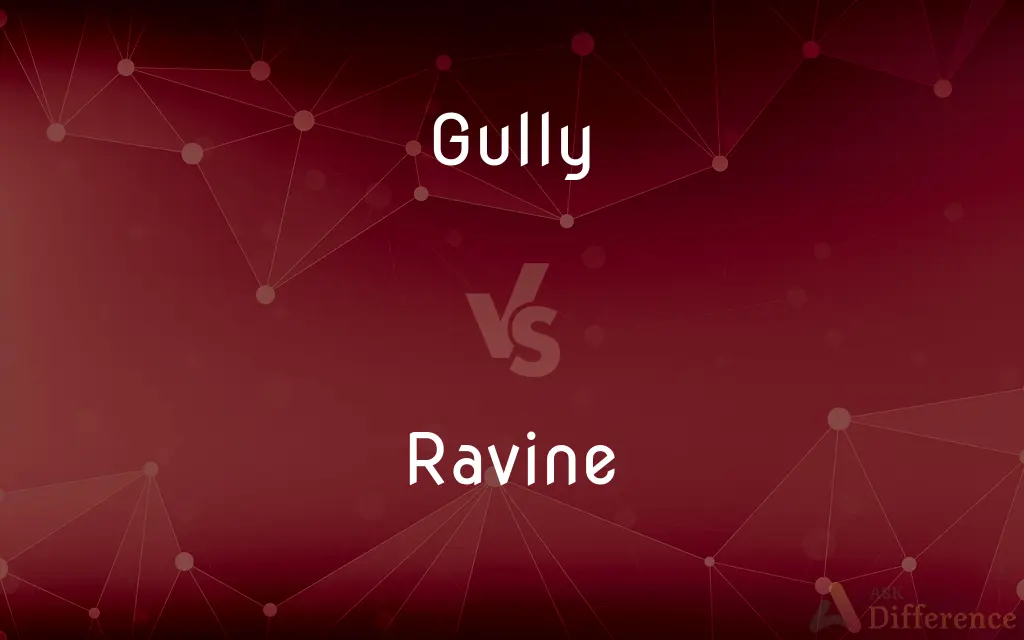Gully vs. Ravine — What's the Difference?
By Fiza Rafique & Urooj Arif — Updated on March 25, 2024
A gully is a small, narrow cut in the earth formed by running water, while a ravine is a larger, deeper natural depression, often with steep sides.

Difference Between Gully and Ravine
Table of Contents
ADVERTISEMENT
Key Differences
Gullies and ravines are both erosional features created by water, but they differ significantly in size and formation. A gully is smaller, formed by the action of surface water, and is a sign of severe soil erosion. It usually starts as a small channel caused by rainfall runoff. Ravines, on the other hand, are much larger and deeper than gullies, often formed by the prolonged action of a river or stream cutting into the earth, creating steep sides.
The formation of a gully is typically a more rapid process, occurring as water accumulates and flows in small channels after heavy rainfall, leading to soil erosion. This makes gullies common in areas with loose, easily eroded soil. Ravines are formed over much longer periods, where persistent water flow carves deep into the landscape, and they can be found in a variety of geological settings, including both soft and hard rock areas.
Gullies are often seen in agricultural or deforested lands where the ground cover is insufficient to retain soil, highlighting the human impact on the environment. Ravines, while they can also be affected by human activity, often occur in more natural settings, such as forests and mountainous regions, serving as significant landscape features that can offer biodiversity hotspots.
In terms of ecological impact, gullies can significantly alter the landscape by redirecting surface water and contributing to soil degradation, which affects agricultural productivity and local ecosystems. Ravines, being larger and more stable structures, often harbor unique ecosystems, providing habitats for various plants and animals and acting as natural corridors for wildlife.
The terminology used to describe these features can vary regionally, with terms like "ditch" or "trench" sometimes used interchangeably with gully in casual conversation. However, "ravine" is more consistently used to refer to larger, more dramatic erosional features that have a clear impact on the landscape.
ADVERTISEMENT
Comparison Chart
Size
Small, narrow
Large, deep
Formation
Rapid erosion by running water
Long-term erosion by rivers or streams
Characteristics
Shallow, more likely to change
Deep with steep sides, more permanent
Location
Common in agricultural, deforested areas
Often in natural settings like forests
Ecological Impact
Leads to soil degradation
Supports diverse ecosystems
Compare with Definitions
Gully
Contributes to soil loss and degradation, affecting local ecosystems.
Gully erosion not only changes the landscape but also reduces the land's agricultural value.
Ravine
A deep, narrow depression in the earth's surface, formed by water erosion and characterized by steep sides.
The ravine, with its steep sides, has been carved out by the river over thousands of years.
Gully
Can be reclaimed through engineering and vegetation.
Through careful planning, the once eroded gully has been reclaimed and now supports a variety of plant life.
Ravine
Important for biodiversity and water management.
Conserving ravines is crucial for maintaining the area's biodiversity and ensuring the health of the watershed.
Gully
A small channel carved in the earth by running water, indicative of severe erosion.
After the heavy rain, a new gully formed on the hillside, showing clear signs of erosion.
Ravine
Can offer scenic views and hiking trails.
The ravine's dramatic landscape has made it a popular spot for hikers and nature enthusiasts.
Gully
Results from surface water erosion, often after heavy rainfall.
The formation of gullies on farmland can significantly impact soil stability and fertility.
Ravine
Created by the prolonged action of streams or rivers.
Over millennia, the river eroded the landscape, forming a deep ravine that cuts through the forest.
Gully
Requires soil conservation practices to prevent formation.
Planting vegetation and building terraces are effective methods for preventing gully erosion.
Ravine
Often hosts diverse ecosystems and serves as wildlife habitats.
The ravine is home to numerous species, serving as a vital corridor for migratory birds.
Gully
A gully is a landform created by running water, eroding sharply into soil or other relatively erodable material, typically on a hillside. Gullies resemble large ditches or small valleys, but are metres to tens of metres in depth and width.
Ravine
A ravine is a landform that is narrower than a canyon and is often the product of streambank erosion. Ravines are typically classified as larger in scale than gullies, although smaller than valleys.
Gully
A ravine formed by the action of water.
Ravine
A deep, narrow gorge with steep sides.
Gully
A fielding position on the off side between point and the slips
He was caught in the gully by Jones
Ravine
A deep narrow valley or gorge in the earth's surface worn by running water.
Gully
An alley.
Ravine
A deep narrow valley or gorge in the earth's surface worn by running water.
Gully
(of water) make gullies or deep channels in (land)
He began to pick his way over the gullied landscape
Ravine
(archaic) raven
Gully
A deep ditch or channel cut in the earth by running water after a prolonged downpour.
Ravine
A torrent of water.
Gully
A channel in the side of a mountain, especially one forming a path for avalanches or rockfall.
Ravine
A deep and narrow hollow, usually worn by a stream or torrent of water; a gorge; a mountain cleft.
Gully
A large knife.
Ravine
A deep narrow steep-sided valley (especially one formed by running water)
Gully
To wear a deep ditch or channel in.
Gully
To form a deep ditch or channel.
Gully
A trench, ravine or narrow channel which was worn by water flow, especially on a hillside.
Gully
A small valley.
Gully
(UK) A drop kerb.
Gully
A road drain.
Gully
(cricket) A fielding position on the off side about 30 degrees behind square, between the slips and point; a fielder in such a position
Gully
(UK) A grooved iron rail or tram plate.
Gully
A large knife.
Gully
(India) an alleyway or side street.
Gully
(obsolete) To flow noisily..
Gully
(transitive) To wear away into a gully or gullies.
Gully
A large knife.
Gully
A channel or hollow worn in the earth by a current of water; a short deep portion of a torrent's bed when dry.
Gully
A grooved iron rail or tram plate.
Gully
To wear into a gully or into gullies.
Gully
To flow noisily.
Gully
Deep ditch cut by running water (especially after a prolonged downpour)
Common Curiosities
Are ravines found in specific geographical areas?
Ravines can be found worldwide, in both temperate and tropical regions, wherever long-term erosion by water occurs.
Can gullies be repaired?
Yes, gullies can be repaired through soil conservation measures, reforestation, and engineering works to stabilize the area.
Can a gully become a ravine?
Over time and with continuous erosion, a gully may deepen and widen into a ravine, though this is a long-term process.
How does a ravine differ from a canyon?
While similar, a canyon is typically larger and more dramatic than a ravine, often with very steep, cliff-like sides, and formed in arid climates.
What is the ecological importance of ravines?
Ravines are important for biodiversity, providing habitats for various species and acting as natural corridors for wildlife.
Why is it important to prevent gully erosion?
Preventing gully erosion is crucial for preserving soil health, preventing loss of agricultural land, and protecting local ecosystems.
What role do ravines play in the landscape?
Ravines contribute to the landscape's diversity, offering unique ecosystems and scenic beauty, and play a role in watershed management.
What causes a gully to form?
A gully forms due to water runoff causing soil erosion, especially on sloped, deforested, or overgrazed lands.
How can human activity impact gullies and ravines?
Human activity, such as deforestation, agriculture, and urban development, can exacerbate erosion, leading to the formation of gullies and affecting the stability and ecology of ravines.
How are gullies and ravines similar?
Both are formed by water erosion and serve as channels for water flow, but differ significantly in size and ecological impact.
Share Your Discovery

Previous Comparison
Spikenard vs. Nard
Next Comparison
Disease vs. DisorderAuthor Spotlight
Written by
Fiza RafiqueFiza Rafique is a skilled content writer at AskDifference.com, where she meticulously refines and enhances written pieces. Drawing from her vast editorial expertise, Fiza ensures clarity, accuracy, and precision in every article. Passionate about language, she continually seeks to elevate the quality of content for readers worldwide.
Co-written by
Urooj ArifUrooj is a skilled content writer at Ask Difference, known for her exceptional ability to simplify complex topics into engaging and informative content. With a passion for research and a flair for clear, concise writing, she consistently delivers articles that resonate with our diverse audience.
















































